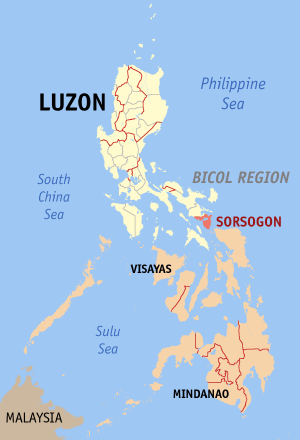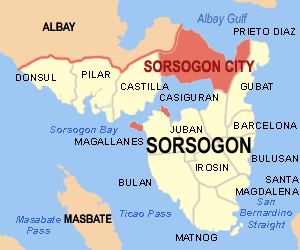Sorsogon
- This article is about the province. For the city, see Sorsogon City and for the bay, see Sorsogon Bay.
| Province of Sorsogon | |
Provincial seal of Sorsogon |
|
 Map of the Philippines with Sorsogon highlighted |
|
| Region | Bicol Region (Region V) |
| Capital | Sorsogon City |
| Divisions | |
| - Highly urbanized cities | 0 |
| - Component cities | 1 |
| - Municipalities | 14 |
| - Barangays | 541 |
| - Congressional districts | 2 |
| Population | 37th largest |
| - Total (2007) | 650,535 |
| - Density | 304 /km² (787 /sq mi) (19th highest) |
| Area | 22nd smallest |
| - Total | 2,141.4 km2 (827 sq mi) |
| Founded | — |
| Spoken languages | Bikol |
| Governor | Sally Ante Lee (Lakas-CMD) |
Sorsogon is a province of the Philippines located in the Bicol Region; it is the southernmost province in Luzon and is subdivided into fourteen (14) municipalities(towns) and one city. Its capital is Sorsogon City (formerly towns of Sorsogon and Bacon) and borders the province of Albay to the north. Sorsogon is at the tip of the Bicol Peninsula and faces the island of Samar to the southeast across the San Bernardino Strait and Ticao Island to the southwest.
Contents |
Geography
Sorsogon, at the southeastern part of the Bicol Peninsula, is bounded on the north by the province of Albay, on the east by the Pacific Ocean, on the south by the San Bernardino Strait, and on the west and northwest by the Ticao and Burias Passes. It has a total land area of 2,141.4 sq. km.
It is characterized by an irregularly topography, except for landlocked Irosin, all the towns lie along the coast. They are all connected by concrete and asphalt roads. Mountains sprawl over the northeast, southeast and west portions. Mt. Bulusan, the tallest peak rises 1,560 meters above sea level.
Except for its overland link with the province of Albay to the north, it is completely surrounded by water. Sorsogon is the gateway of Luzon to the Visayas and Mindanao through its roll-on, roll-off ferry terminal facilities located in the municipalities of Matnog and Bulan.
Economy
The province's economic activity is highly concentrated in its capital city, Sorsogon City, and the towns of Bulan, and Matnog as well. Sorsogon Province is classified as 2nd class with an average annual income of Php 339.4M (C.Ys. 2000-2003). This is about Php11M short for the province to attain 1st class reclassification which requires at least Php 350M average annual income.
The Province of Sorsogon indeed had a great contribution on the 97-percent growth in investments for the first quarter of 2008 and increasing tourism arrivals that buoyed the Bicol Region economy, despite the damage brought about by incessant rains and the rice shortage. This is according to the Quarterly Regional Economic Situationer (QRES) released by the National Economic and Development Authority (NEDA) Regional Office in Bicol (NRO 5).
Among the provinces, Sorsogon posted the highest growth (293% respectively) in investments from the previous year. Next to Sorsogon is Catanduanes that posted a growth of 280%. Albay contributed 39 percent to the region's investments and posted a growth of 221 percent from the preceding quarter.
“For the third time, Bicol Region hosted the kick-off of Asia's premier extreme sailing event, the Philippine Hobie Challenge last February 16 at Gubat, Sorsogon. This 260-mile journey from Gubat-Sambuyan-Bacsal-Marambut-Suluan[1] to Siargao enticed both local and foreign water sports enthusiasts. It opened the opportunity for the municipality of Gubat to showcase the town's best,” the QRES stated.
People and culture
Festivals
Most of the inhabitants of the province belong to the ethnolinguistic Bicolano and Bisakol groups. Sorsogon was once a part of Albay and once also included Masbate. Sorsogueños are very religious and funloving. Being mostly Roman Catholics, they are active in every festivity celebrated throughout the year. For instance, like any other Filipino ethnolinguistic groups, they celebrate the fiesta of the Patron Saints Peter and Paul in Sorsogon city every June. Also, by the last week of October, the Kasangayahan festival is celebrated in the whole province. At the midst of the latter festivity, myriads of botanical shows, and painting are conducted. Most of the people will hang out in carnivals and concerts. Another occasion is the Pili festival, which includes street dancing by locals donning Pili nut costumes, cooking competitions, fireworks displays, and even a nutcracking session along the road by the locals. Every barangay has its own fiesta and Patron saint which are highlighted by yearly buffet feast in every Sorsogueño home.
During the Holy Week season (celebrated as early as week of March or 1st week of April), people flock to the Saints Peter and Paul cathedral and start the procession in barefoot, with carts bearing statues of Jesus Christ on his way to crucifixion.
Minorities
Minorities include Muslim immigrants from Mindanao, who engage in street vending and small shop businesses. A mosque is situated inside Sitio Bolangan on the outskirts of the city. A significant small Chinese population who are owners of hardware stores and commodity shops and dwell in the business center. Indian communities are also present and are Hindus. They are typically known to engage in money lending businesses --colloquially called "five-six".
Education and language
Education is highly valued as an investment for the future, attested by state and private schools and colleges which dot the province. Almost all people understand Tagalog and Bicolano. The local language spoken by Sorsogueños varies from district to municipalities. To illusrate, the form of Bisakol (called Waray Sorsogon) spoken in Barcelona, Gubat, Irosin, Sta. Magdalena, Matnog and Bulusan slightly differs from the form (called Masbate Sorsogon) spoken in the city of Sorsogon and the municipalities of Magallanes, Juban and Casiguran. North of Sorsogon City, in Castilla, Pilar, Donsol, and Bacon (merged with Sorsogon city; see History), a form of Bikol is spoken. The former municipalities mentioned use words and intonations from Visayan languages such as Waray-Waray, Cebuano and Ilonggo, and Bisakol is considered a Warayan language like Waray-Waray of Samar and Leyte. English is also understood by most educated people. It is used in all government documents, schools, and in business. This language has also become increasingly important as businesses such as call centers, and medical transcription require prospective applicants to be proficient in it.
Political
Sorsogon is subdivided into 14 municipalities and 1 city. Albay Gulf lies to the north, Ticao Pass between Sorsogon and Ticao Island, and San Bernardino Strait in the south.

| City/Municipality | No. of Barangays |
Area (km²) |
Population (2000) |
Mayor ) |
|
|---|---|---|---|---|---|
| Barcelona |
|
||||
| Bulan |
|
||||
| Bulusan |
|
||||
| Casiguran |
|
||||
| Castilla |
|
||||
| Donsol |
|
||||
| Gubat |
|
||||
| Irosin |
|
||||
| Juban |
|
||||
| Magallanes |
|
||||
| Matnog |
|
||||
| Pilar |
|
||||
| Prieto Diaz |
|
||||
| Santa Magdalena |
|
||||
| Sorsogon City |
|
||||
Post 1986 people power uprising
In 2000, the municipalities of Bacon and Sorsogon was merged to create Sorsogon City.[2]
References
- ↑ Philippine Hobie Challenge Wiki.Alumni.NET, Accessed August 2008.
- ↑ NSCB - 2001 Factsheet - 12 New Cities Created, July-December 2000.
External links
|
||||||||